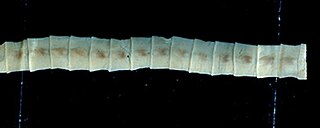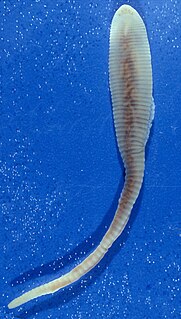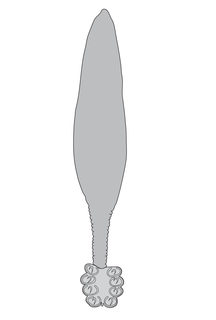Related Research Articles

Diphyllobothrium is a genus of tapeworms which can cause diphyllobothriasis in humans through consumption of raw or undercooked fish. The principal species causing diphyllobothriasis is D. latum, known as the broad or fish tapeworm, or broad fish tapeworm. D. latum is a pseudophyllid cestode that infects fish and mammals. D. latum is native to Scandinavia, western Russia, and the Baltics, though it is now also present in North America, especially the Pacific Northwest. In Far East Russia, D. klebanovskii, having Pacific salmon as its second intermediate host, was identified.

The Caryophyllideans are a group of tapeworms that infect fish and annelids with a simple scolex or "head." Worms in this order only have one proglottid, which is believed to be the primitive condition for tapeworms. They are generally less than 10 centimetres long. Caryophillideans represent a unique type of tapeworm, such that they possess a monzoic, unsegmented, body, with only a single set of reproductive organs.

Eucestoda, commonly referred to as tapeworms, are the larger of the two subclasses of flatworms in the class Cestoda. Larvae have six posterior hooks on the scolex (head), in contrast to the ten-hooked Cestodaria. All tapeworms are endoparasites of vertebrates, living in the digestive tract or related ducts. Examples are the pork tapeworm with a human definitive host, and pigs as the secondary host, and Moniezia expansa, the definitive hosts of which are ruminants.

The Pentastomida are an enigmatic group of parasitic arthropods commonly known as tongue worms due to the resemblance of the species of the genus Linguatula to a vertebrate tongue. They are traditionally seen as crustaceans, even if that position has been questioned.

The Terebellidae is a marine family of polychaete worms, of which the type taxon is Terebella, described by Carl Linnaeus in his 1767 12th edition of Systema Naturae.

The pale-edged stingray or sharpnose stingray is a species of stingray in the family Dasyatidae, found in the Indian and Pacific Oceans from India to the western Malay Archipelago and southern Japan. This bottom-dwelling ray is most commonly found over sandy areas shallower than 100 m (330 ft), as well as in estuaries. Measuring up to 29 cm (11 in) across, the pale-edged stingray has a diamond-shaped pectoral fin disc, a long projecting snout, small eyes, and a whip-like tail with both dorsal and ventral fin folds. It is chocolate brown above and white below.

The thorny-headed worm family Polymorphidae contains endoparasites which as adults feed mainly in fish and aquatic birds. When this taxon was erected by Meyer in 1931, a subfamily Polymorphinae was established in it. As the Polymorphidae as presently understood would then be monotypic, with no basal genera outside the Polymorphinae, the proposed subfamily is redundant for the time being and therefore most modern treatments simply omit it. Polymorphus minutus is an economically significant parasite in goose and duck farming.

Raillietina is a genus of tapeworms that includes helminth parasites of vertebrates, mostly of birds. The genus was named in 1920 in honour of a French veterinarian and helminthologist, Louis-Joseph Alcide Railliet. Of the 37 species recorded under the genus, Raillietina demerariensis, R. asiatica, and R. formsana are the only species reported from humans, while the rest are found in birds. R. echinobothrida, R. tetragona, and R. cesticillus are the most important species in terms of prevalence and pathogenicity among wild and domestic birds.

Microcotyle is a genus which belongs to the phylum Platyhelminthes and class Monogenea. Species of Microcotyle are ectoparasites that affect their host by attaching themselves as larvae on the gills of the fish and grow into adult stage. This larval stage is called oncomiracidium, and is characterized as free swimming and ciliated.
Aggregata is a genus of parasitic alveolates belonging to the phylum Apicomplexa.
Oochoristica is a genus of tapeworms.

Opecoelidae is a family of trematodes. It is the largest digenean family with over 90 genera and nearly 900 species, almost solely found in marine and freshwater teleost fishes. It was considered by Bray et al. to belong in the superfamily Opecoeloidea Ozaki, 1925 or the Brachycladioidea Odhner, 1905.

Lethrinus atkinsoni is a species of emperor fish described by Alvin Seale in 1910. It is commonly 30 to 35 cm long with a bluish-grey, yellowish, or tan in colour, and a white belly. This species is widespread throughout the west Pacific Ocean. It is a reef-associated fish and is non-migratory. It is solitary or is found in small schools, and lives in seagrass beds and over the sandy bottoms feeding on plankton, mollusks, crustaceans, and other fishes. This fish is caught by humans for food, but less so than other species in the genus due to its small size.

Lethrinus rubrioperculatus, common names the spotcheek emperor, red-eared emperor, red-ears, red-edged emperor, scarlet-cheek emperor, and spot cheek emperor, is a species of emperor fish.

Louis Euzet was a French parasitologist.
Hexabothriidae is a family of monogenean parasites. The family name was proposed by Emmett W. Price in 1942. The family includes 14-16 genera according to authors and about 60 species; all are parasitic on the gills of chondrichthyan fishes.

Chimaericola is a genus of parasitic flatworms in the family Chimaericolidae. The genus was created by August Brinkmann in 1942. Species are parasitic on the gills of Chimaeras.

Diphyllobothriidea is a family of Cestoda (tapeworms). Members of this family are gut parasites of vertebrates. In most species the definitive hosts are marine or aquatic mammals such as cetaceans and pinnipeds, the first intermediate host usually being a crustacean and the second intermediate a fish. The genus Diphyllobothrium is found as an adult in mammals and fish-eating birds, including the domestic cat. The genus Spirometra tends to have a land-dwelling or semi-aquatic vertebrate as its second intermediate host, with the adults usually occurring in felines.

Laticola is a genus of monopisthocotylean monogeneans, belonging to the family Diplectanidae. All known species are parasitic on the gills of marine fish, including members of Lates (Latidae) and Epinephelus (Serranidae).
References
- 1 2 Leuckart R. 1878. Archigetes sieboldi, eine geschlechtsreife Cestodenamme. Zeitschrift für Wissenschaftliche Zoologie, 30 (Suppl.), 593–606.
- ↑ WoRMS (2021). Archigetes Leuckart, 1878. Accessed at: http://www.marinespecies.org/aphia.php?p=taxdetails&id=1511810 on 2022-01-14
- ↑ Mrázek A. 1908. Ueber eine neue Art der Gattung Archigetes. Zentralblatt für Bakteriologie und Parasitenkunde. 46, 719–723.
- ↑ Wiśniewski LW. 1928. Archigetes cryptobothrius n. sp. nebst Angaben die Entwicklung im Genus Archigetes, R. Leuck. Zoologischer Anzeiger, 77, 113-124.
- ↑ Calentine RL. 1962. Archigetes iowensis sp. n. (Cestoda: Caryophyllaeidae) from Cyprinus carpio L. and Limnodrilus hoffmeisteri Claparède. Journal of Parasitology, 48, 513–524
- ↑ Kennedy CR. 1965. Taxonomic studies on Archigetes Leuckart, 1878 (Cestoda, Caryophyllidea). Parasitology, 55, 439–451.